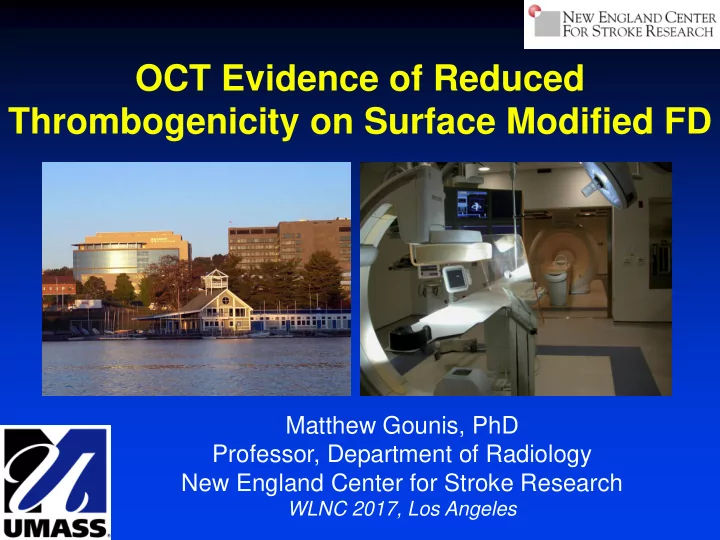

OCT Evidence of Reduced Thrombogenicity on Surface Modified FD Matthew Gounis, PhD Professor, Department of Radiology New England Center for Stroke Research WLNC 2017, Los Angeles
Introduction • In vitro- Pipeline Flex Embolization Device + Shield Technology TM (Shield)-surface modification consisting of a 3nm thick modified phosphorylcholine is less thrombogenic. 1 • Hypothesis- Shield has less thrombus formation in vivo as compared to uncoated Pipeline Embolization Devices (PED) regardless of dual antiplatelet therapy (DAPT) 1 G Girdhar et al. J Thromb Thrombolysis. 2015;40:437-443
Optical Coherence Tomography • OCT- uses near infra- red light for HR imaging • Catheter- DragonFly (St. Jude Medical)- – 54mm HR pullback – 20mm rapid exchange with 2.7F profile – 0.014’ guidewire and 6G guide catheter compatible
Comparison DSA OCT
Comparison DSA s/p Angioplasty
Methods: study design, protocol • Rabbit Elastase-aneurysm model • 4 groups, 10 rabbits in each group: (cPED- Pipeline Classic, sPED- Pipeline Flex with Shield technology) 12 10 8 DAPT 6 No DAPT 4 2 0 cPED sPED cPED sPED • DAPT group- 10mg/kg/day clopidogrel and ASA, p.o. 5 days prior implant to 30 days • OCT used for assessing: Clot formation on the surface of device
Baseline Data (mm) (mm) One-way ANOVA (mm) (mm) (mm) (mm)
Methods: imaging protocol • FD implant: 1) DSA: pre-implant 2) VasoCT: pre-implant 3) DSA: post-implant 4) OCT: post-implant 5) DSA: post-angioplasty 6) OCT: post-angioplasty 7) VasoCT: post-angioplasty Blood clearance for OCT – power injection • 5ml/s, 3.5s, Omnipaqe 240mgI/ml
Methods: Thrombus Quantitation • After implant, optical coherence tomography (OCT, Dragonfly, St Jude) was performed before and after angioplasty, and at terminal follow-up. • Thrombus formation was assessed at 4 locations along the implant as present or absent
Results: procedure and complications FD implant: – 45 devices implanted, • 44 cases complete neck coverage (98%) – no vessel perforation, – 1 vessel dissection: innominate artery, proximal to FD (2%), blood flow not compromised – kept in study – No visible thromboembolic complication on DSA
Results: clot formation D- distal, DA- distal to the aneurysm, PA- proximal to the aneurysm, SBO- side branch origin SBO D D D DA DA PA PA cPED – NO DAT, score:4 Score: 0-4
Results: clot formation
Results • Animals receiving DAPT had a significant reduction in PRU values (69±28 vs 247±41, p=0.0039) and non-significant reduction in ARU (649±31 vs 659±9, p=0.2) • Shield significantly reduced the presence of clot formation (p<0.0001) • Clot formation was not associated with DAPT (p=0.4) or neck size (p=0.7).
Conclusion • Shield technology reduces acute thrombus formation regardless of DAPT has been confirmed in vivo using OCT • Shield reduces thrombus at SBOs • OCT offers quantifiable insight into the device-anatomy interface
• UMass Collaborations NECStR – Marc Fisher, MD – Neil Aronin, MD – Ajay Wakhloo, MD, PhD – Alexei Bogdanov, PhD – Ajit Puri, MD – Greg Hendricks, PhD – Juyu Chueh, PhD – Guanping Gao, PhD – Miklos Marosfoi, MD – Miguel Esteves, PhD – Martijn van der Bom, PhD – Linda Ding, PhD – Kajo van der Marel, PhD – Srinivasan Vedantham, PhD – Anna Kühn, MD, PhD – John Weaver, MD – Ivan Lylyk, MD • Collaborations – Frédéric Claren ҫ on, MD, PhD – Youssef Wadghiri, PhD - NYU – Mary Howk, MS, CRC – Peter Caravan, PhD - MGH – Thomas Flood, MD, PhD – Italo Linfante, MD - MCVI – Erin Langan, BS – Guilherme Dabus, MD - MCVI – Olivia Brooks, BS – Don Ingber, PhD – Harvard – Robert King, MS – Netanel Korin, PhD - Technion – Chris Brooks, PA – Ricardo Hanel, MD and Eric – Shaokuan Zheng, PhD Sauvageau, MD - Baptist – Raul Nogueira, MD - Emory
Recommend
More recommend